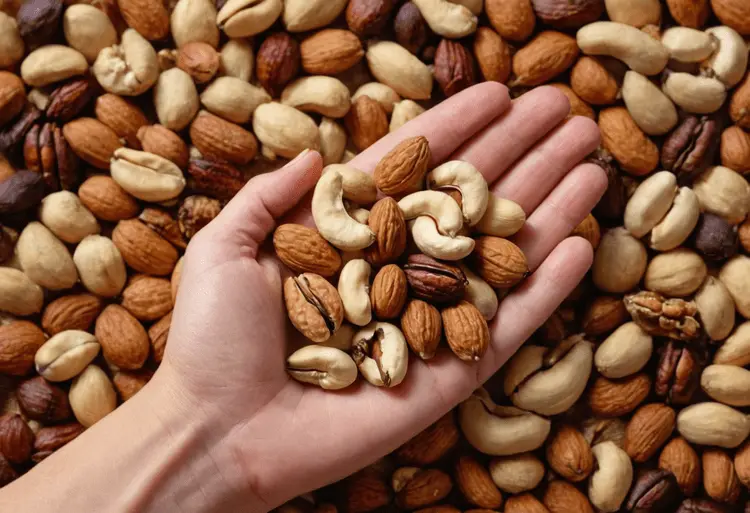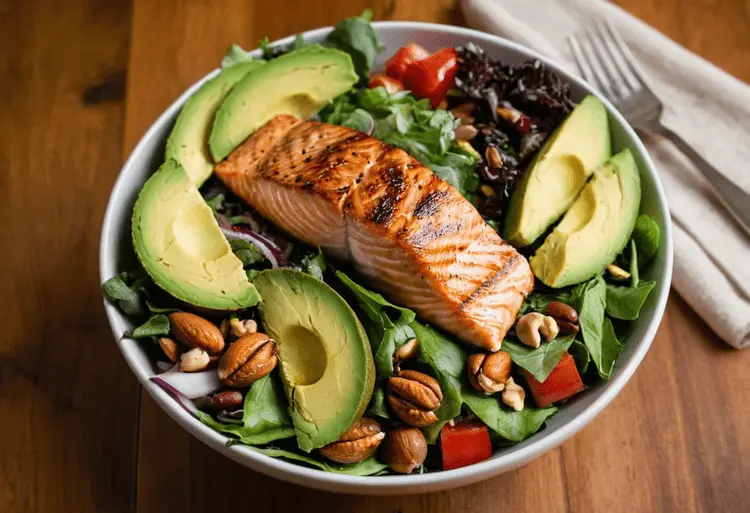Fat-Protein Efficient Diet (FPED): Your Passport to Lasting Weight Loss and Vibrant Health
Tired of restrictive diets that leave you feeling deprived and counting down the minutes until your next meal?
The fat-protein efficient diet (FPED) offers a refreshing alternative, focusing on delicious, satiating foods that nourish your body and promote lasting weight loss.
But what exactly is FPED, and how does it work?
This innovative approach, sometimes called a protein and fat diet, flips the script on traditional low-fat diets. It prioritizes protein-rich meals and healthy fats for weight loss, tapping into your body’s natural ability to burn fat for fuel.
Imagine a way of eating that doesn’t just help you shed pounds, but also boosts your energy, sharpens your focus, and leaves you feeling completely satisfied. That’s the power of FPED.
Ready to discover a fat-burning diet that actually feels good?
Let’s explore how FPED can transform your relationship with food and your body, starting with understanding the science behind metabolic flexibility and the optimal macronutrient ratio for your unique needs.
Fat-Protein Efficient Diet (FPED) at a Glance
- Sustainable weight loss
- Prioritizes healthy fats
- Emphasizes protein intake
- Promotes metabolic flexibility
- Boosts energy & focus
Table of contents
- Fat-Protein Efficient Diet (FPED) at a Glance
- Introduction: Your Path to Optimal Health
- The Science Behind the Fat Protein Efficient Diet (FPED)
- Foods to Fuel Your Fat-Protein Efficient Diet (FPED)
- FPED Meal Plans and Recipes
- Getting Started with the Fat-Protein Efficient Diet
- Embrace the Fat-Protein Efficient Lifestyle
- Your Burning Questions About the Fat-Protein Efficient Diet Answered
Introduction: Your Path to Optimal Health

Tired of yo-yo dieting and unsustainable weight loss plans? Ever wondered if there’s a way to eat delicious, satisfying food that also fuels your body for peak performance? The answer might be closer than you think.
Introducing the Fat-Protein Efficient Diet (FPED)
The fat protein efficient diet isn’t just another fad. It’s a science-backed approach that prioritizes healthy fats and protein while moderating carbohydrates.
This unique combination unlocks your body’s natural fat-burning potential, leading to sustainable weight loss and a host of other benefits.
But what makes FPED truly different? Unlike restrictive diets, it embraces metabolic flexibility, the ability to seamlessly switch between using carbs and fat for energy. This not only makes it easier to stick to long-term but also promotes optimal health on a cellular level.
Beyond Weight Loss: Unleash Your Potential
Imagine waking up feeling energized, focused, and ready to conquer your day. With FPED, this isn’t just a dream – it’s your new reality. Beyond shedding pounds, this diet enhances mental clarity, stabilizes energy levels, and supports long-term well-being.
Whether you’re a fitness enthusiast, a busy professional, or simply looking to feel your best, FPED can help you unlock your full potential.
Your Journey Starts Here
Ready to embark on a transformative journey towards a healthier, happier you? Join us as we delve into the science, the food, and the lifestyle that make the fat protein efficient diet your ultimate guide to sustainable weight loss and optimal health.
Share Your Thoughts!
Have you tried FPED before? We’d love to hear your experiences! Leave a comment below or tag us on social media with your questions and success stories. Let’s create a supportive community where we can learn and grow together.
Mastered the fat-protein efficient diet? Awesome! Ready to level up your results? Explore the 90-30-50 Diet Plan for a structured approach and even more delicious meal options.
The Science Behind the Fat Protein Efficient Diet (FPED)
Ever wonder why some diets seem to work better for certain people? Why you might thrive on a low-carb plan while your friend feels sluggish? It all comes down to metabolic flexibility, a key concept in the fat protein efficient diet (FPED).
Macronutrient Magic: The Ideal Fat, Protein, and Carb Ratio
Let’s talk numbers. Unlike other low-carb diets, FPED emphasizes healthy fats over excessive protein. This doesn’t mean ditching carbs entirely. Instead, it focuses on finding the right balance for your body’s unique needs.
Think of it like this:
- Fats: Roughly 50-60% of your daily calories
- Protein: Approximately 30% of your daily calories
- Carbohydrates: Around 10-20% of your daily calories, primarily from low-glycemic options
Why the focus on fat? Because FPED aims to switch your body’s primary fuel source from glucose (carbs) to ketones (fat). This is where the magic of ketosis comes in.
The Ketosis Connection: Unleashing Your Fat-Burning Potential
Ketosis is a metabolic state where your body starts burning stored fat for energy. This isn’t just about shedding pounds. It’s about unlocking a whole range of benefits, from improved focus and mental clarity to sustained energy levels throughout the day.
But here’s the twist: FPED doesn’t force you into strict ketosis. Instead, it promotes a gentle, sustainable approach that prioritizes metabolic flexibility.
Metabolic Flexibility: The Key to Long-Term Success
Metabolic flexibility is your body’s ability to seamlessly switch between using carbs and fat for fuel. This is crucial for maintaining a healthy weight and optimal well-being.
FPED helps you develop this flexibility by gradually adjusting your macronutrient intake. Over time, your body becomes more efficient at burning fat, even when you occasionally indulge in carbs.
Foods to Fuel Your Fat-Protein Efficient Diet (FPED)

Ready to dive into the delicious world of FPED? This isn’t about deprivation, folks. It’s about nourishing your body with foods that love you back.
Fats: Your New Best Friends
Forget those old myths about fat! On the fat protein efficient diet, healthy fats are your allies in feeling full, satisfied, and energized.
- Indulge in:
- Creamy avocado: Nature’s butter, packed with fiber and nutrients.
- Rich olive oil: Drizzle it generously on salads and veggies.
- Crunchy nuts and seeds: Snack on almonds, walnuts, chia, or flax.
- Fatty fish: Salmon, tuna, mackerel – oh my, the omega-3s!
But wait, not all fats are created equal. Limit or avoid:
- Processed fats: Say no to hydrogenated oils and trans fats.
- Fried foods: Those crispy temptations are not your friends.
- Refined vegetable oils: Opt for healthier alternatives like olive or avocado oil.
Protein Powerhouses: Building Blocks for Your Body
Protein isn’t just for bodybuilders! It’s essential for everyone following a fat protein efficient diet to maintain muscle mass, regulate blood sugar, and curb cravings.
- Savor:
- Meat, poultry, fish: Choose grass-fed, pasture-raised, or wild-caught for maximum nutrition.
- Eggs: These golden orbs are a protein powerhouse.
- Dairy: Full-fat yogurt, cheese, and butter are welcome here.
- Plant-based options: Tofu, tempeh, lentils, beans – vegetarian and vegan friends, we’ve got you covered!
Carbohydrates: Choose Wisely
Carbs aren’t the enemy, but we’re getting picky on the fat protein efficient diet. Prioritize low-glycemic options to keep your blood sugar stable and energy levels humming.
- Fill your plate with:
- Non-starchy vegetables: Think leafy greens, broccoli, cauliflower, and bell peppers.
- Berries: These little gems are packed with antioxidants and fiber.
Hold the phone on these high-carb culprits:
- Refined grains: White bread, pasta, pastries – they’ll spike your blood sugar.
- Sugary snacks: Candy, soda, and desserts are out of the picture.
- Processed foods: Avoid anything with a laundry list of unpronounceable ingredients.
Bonus Tip: Many non-starchy vegetables and berries are also low-glycemic options – double win! Check out this comprehensive list of [low-glycemic options] to guide your choices.
FPED Meal Plans and Recipes
Are you ready to dive into the delicious world of fat-protein efficient meals? Buckle up, because we’re about to embark on a culinary adventure that will nourish your body and tantalize your taste buds.
Sample Meal Plans: Your Roadmap to Success
The fat protein efficient diet isn’t one-size-fits-all. We’ve crafted three levels of meal plans – beginner, intermediate, and advanced – to guide you on your journey, no matter where you’re starting.
- Beginner: Ease into FPED with a gentle shift in macros, focusing on whole foods and simple recipes.
- Intermediate: Amp up the healthy fats and experiment with more diverse flavors and cooking techniques.
- Advanced: Master the art of metabolic flexibility and fine-tune your meals for optimal results.
Remember, these are just templates! Feel free to swap out ingredients to match your preferences and dietary needs. You’re the chef of your own kitchen!
Recipe Ideas: Fuel Your Body, Delight Your Senses
Let’s get cooking! Here are some mouthwatering FPED-friendly recipe ideas to inspire your culinary creativity:
Breakfast:
- Egg-cellent Start: Whip up a fluffy omelet loaded with veggies and a sprinkle of cheese.
- Chia Seed Power: Soak chia seeds in coconut milk overnight for a creamy, protein-packed pudding.
- Smoothie Sensations: Blend spinach, berries, protein powder, and avocado for a vibrant breakfast on the go.
Nutritional information for omelet: 280 calories, 20g fat, 22g protein, 5g carbs.
Lunch/Dinner:
- Salad Symphony: Toss leafy greens with grilled chicken or fish, avocado, nuts, and a drizzle of olive oil.
- Stir-Fry Fiesta: Sizzle your favorite veggies and protein in coconut oil with a flavorful low-carb sauce.
- Soupy Satisfaction: Warm up with a hearty bone broth-based soup packed with veggies and protein.
Nutritional information for stir-fry: 450 calories, 30g fat, 35g protein, 10g carbs.
Snacks:
- Nutty Delights: Grab a handful of almonds, walnuts, or macadamia nuts for a satisfying crunch.
- Hard-Boiled Goodness: Peel and enjoy a protein-rich hard-boiled egg sprinkled with salt and pepper.
- Veggies and Dip: Slice up cucumbers, bell peppers, or celery and pair them with a creamy guacamole.
Want to take your culinary skills to the next level? Explore the vast world of low-glycemic options to keep your blood sugar stable and your energy levels high.
What’s your go-to FPED recipe? Share your favorite dishes in the comments or tag us on social media. Let’s create a community of fat-protein efficient foodies!
Getting Started with the Fat-Protein Efficient Diet
Ready to embark on your fat-protein efficient diet (FPED) journey? Fantastic! But how do you actually start? And what can you expect along the way? Let’s dive in.
Transitioning Tips: Slow and Steady Wins the Race
Ever heard the saying, “Rome wasn’t built in a day”? Drastically cutting carbs might sound tempting, but a gradual approach is key. Slowly reduce carbs while increasing healthy fats and protein. This gives your body time to adapt and minimizes any “keto flu.”
Track Your Macros: Knowledge is Power
What are macros? They’re the three main components of your diet: fat, protein, and carbohydrates. Tracking helps you stay within the recommended ranges for FPED: 50-65% fat, 25-35% protein, and 5-10% carbs. Apps and websites can make this easy.
Aim for consistency over perfection. Life happens, and it’s okay to have an extra treat. Just get back on track with your next meal. For further information and insights, explore this informative article on metabolic flexibility.
Listen to Your Body: It’s Smarter Than You Think
Your body is your best guide. Pay attention to how you feel after meals. Are you satisfied and energized? Or sluggish and bloated? Adjust your food choices based on these signals.
The goal isn’t just weight loss, but also improved energy and well-being. You can learn more about low-glycemic options to help ease the transition.
Challenges and How to Overcome Them: You’ve Got This!
Feeling under the weather? The “keto flu” (headaches, fatigue) can happen when starting low-carb. Combat this by staying hydrated, getting enough electrolytes, and gradually increasing fat intake.
Worried about social situations? Eating out is doable on FPED. Choose protein and vegetable-based dishes, and don’t be afraid to ask for modifications.
Nutritional Information: FPED is typically lower in calories than a standard American diet. The exact calorie count varies based on individual needs. Consult a professional for personalized guidance.
We’re here to support you! Share your experiences, ask questions, and connect with fellow FPED enthusiasts. Tag us on social media or leave a comment below.
Embrace the Fat-Protein Efficient Lifestyle

As we wrap up our exploration of the fat-protein efficient diet, let’s recap why this approach is so powerful. FPED isn’t just another fad diet; it’s a sustainable lifestyle that prioritizes your well-being.
What does this mean for you?
- Sustainable Weight Loss: By leveraging your body’s natural fat-burning abilities, you can achieve and maintain a healthy weight without feeling deprived.
- Enhanced Energy and Focus: Say goodbye to the energy crashes and brain fog associated with high-carb diets. FPED fuels your body and mind for peak performance.
- Improved Metabolic Health: By promoting metabolic flexibility, FPED helps you optimize blood sugar levels, reduce inflammation, and lower your risk of chronic diseases.
But the benefits don’t stop there. Many people on FPED report improved sleep, better digestion, and even clearer skin. It’s not just about the number on the scale; it’s about feeling your best from the inside out.
Ready to Take the Leap?
So, is the fat-protein efficient diet right for you? That’s a question only you can answer. But if you’re looking for a sustainable, science-backed approach to weight loss and overall health, FPED might just be the missing piece of your wellness puzzle.
Thriving on the fat-protein efficient diet? Discover how to tailor it for diabetes management. Explore our diabetic diet tips for balanced blood sugar and optimal health.
Your Burning Questions About the Fat-Protein Efficient Diet Answered
You’ve got questions, and we’ve got answers! Let’s tackle some common curiosities about the fat-protein efficient diet (FPED).
The ketogenic (keto) diet, carnivore diet, and some low-carb diets are primarily based on fat and protein. The fat-protein efficient diet is also an option, prioritizing these macronutrients for weight loss and health benefits.
60 30 10 refers to a macronutrient ratio where 60% of your daily calories come from fat, 30% from protein, and 10% from carbohydrates. This ratio is often used in ketogenic or low-carb diets, including the fat-protein efficient diet.
A fat and protein metabolism means your body is efficient at using these macronutrients for energy. People with this type of metabolism may feel better and lose weight more easily on a diet higher in fat and protein, like the FPED.
Not necessarily. It’s a great option for many, but consult your doctor before starting any new diet.
Results vary, but many see positive changes (increased energy, reduced cravings) within weeks. Be patient and consistent for best results.
Not at all! FPED emphasizes delicious, satisfying foods like avocado, nuts, and fatty fish. You’ll likely feel full and energized.
Yes! Choose protein and healthy fat-rich dishes, like grilled meats, fish, or salads with olive oil-based dressings. Ask for modifications if needed.